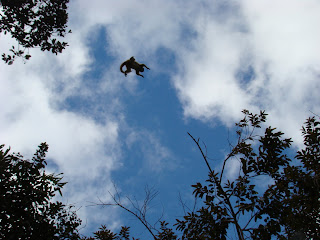




This isn’t entirely true. It is, in fact, only 120 kilometers from Mananara to Moaransetra (pronounced moron-Setr). And yet, how far it is. There is ostensibly a road linking the two, but it is rarely traveled, and I was soon to discover why.
My first attempt at making the trip took the form of a bicycle. I bought it in town and rode it home from the market and was looking forward to the idea of spending a few days on the road, visiting villages and forests along the way. I strapped on my suitcase with some bungee cords and headed off for a brief test-run. Within five minutes, the right pedal had fallen off entirely. Strike one. I returned the bike and got my money back after a difficult argument, difficult mainly because neither of us spoke French all that well and because it was raining. My second attempt was the usual taxi-brusse/bus idea, but there would be no busses that day, nor the next, nor later in the week. Strike two. I decided to check by the port, as I’d seen the captain of the Red Rose, Fabian, at the Lola concert, but the boat was already gone. Strike 3. (I did not go to the “airport” a kilometer north of the city, as there has not been a plane there, public or private, in the last three years.) And then I met Charlie. There was an election in town (one that had already gone down twice, both times with the same results, which, because the opposition party had won (by increasing margins, no less) had been annulled) and Charlie, or so I called him, was the assistant to the vote procurer. He was heading to Moaransetra later that day with the votes in a 4x4, and offered to give me and another stranded person, a Frenchman I was to encounter in various other towns, a lift. (The opposition won again, but the tally has not been certified yet.)
Charlie turned out to be an interesting guy. He was a big soccer fan, liked headcheese, and was very interested in discussing American politics. But he could also be a bit scary when angry. First, he seemed to flip out for no reason. At a bar in Manambolosy (our first, and, it would turn out, longest stop) he boxed a kid’s ears such that his glasses flew off and afterwards sat, arms folded across his chest, fuming in rage. (The problem, it turned out, was that he’d gone into the bar to ask for something salty to eat, and the kid had replied “How about salt?”) The other thing that gave Charlie’s anger an extra edge was the fact that he had a moustache like… Charlie Chaplin. (Hence the nickname.) I honestly didn’t know that was allowed any more.
One of the things that makes the road difficult to drive on is the fact that it’s made of dirt and that there are lots of cyclones in the area that leave the dirt in bad condition. Another thing that makes the driving hard is the fact that the road is intersected by at least a dozen rivers and streams, only a few of which have bridges. Hence the necessity of the barge. In general, crossing streams on barges was a lovely way to break up the drive. At times, though, it proved an added difficulty, especially in Manambolosy where the barge was out of service. (See picture.) Thus, we had to spend the night (the Frenchman and I sharing a bed, the procurer sleeping with a girlfriend who lived there) and, in the morning, some local engineers put together a new barge out of wood planks and empty oil drums. Sketchy, but effective.
In the end, not counting time spent off the road, the driving time was a little over 12 hours. And again, if you don’t want to scroll back to the top, the distance was 120 kilometers. I can’t complain, though. Not only was it a good time, but, once in Moaransetra, the procurer (and his wife) had some good suggestions for things to do, including some killer karaoke at the Baguette D’Or.

















































